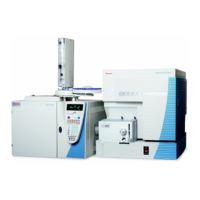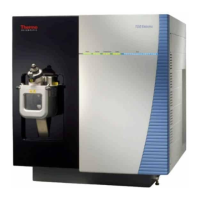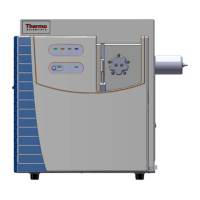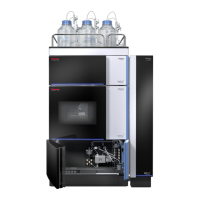4
Daily Operation
Things to Do Before Operating the TSQ System
64 TSQ Series Hardware Manual Thermo Scientific
Checking the Argon and Nitrogen Supplies
Check the argon supply on the regulator of the gas tank. Make sure that you have sufficient
gas for your analysis. If necessary, install a new tank of argon. Verify that the pressure of argon
reaching the mass spectrometer is between 135 ± 70 kPa (20 ± 10 psig). If necessary, adjust
the pressure with the tank pressure regulator.
Check the nitrogen supply on the regulator of the nitrogen gas tank or liquid nitrogen boil-off
tank. Make sure that you have sufficient gas for your analysis. Based on 24-hour per day
operation, typical nitrogen consumption is 2800 liters per day (100 cubic feet per day). If
necessary, replace the tank. Verify that the pressure of nitrogen reaching the mass spectrometer
is between 690 ± 140 kPa (100 ± 20 psig). If necessary, adjust the pressure with the tank
pressure regulator.
Checking the ESI Fused-Silica Sample Tube for Elongation
Using acetonitrile in the mobile phase can cause elongation of the polyimide coating on the
fused-silica sample tube. Elongation of the polyimide coating can degrade signal intensity and
signal stability over time.
If you are running in ESI mode with a fused-silica sample tube, verify the sample tube is not
elongated past the tip of the ESI spray needle. (This elongation does not occur with a metal
needle.)
To cut and reposition the sample tube approximately 0.5 mm (between 0 and 1 mm) inside
the end of the ESI needle, refer to the Ion Max and Ion Max-S API Source Hardware Manual
for more information.
Checking the System Vacuum Levels
For proper performance, your TSQ system must operate at the proper vacuum levels.
Operation of the system with poor vacuum levels can cause reduced sensitivity, tuning
problems, and reduced lifetime of the electron multiplier. You should check your system for
air leaks by checking the system vacuum levels before you begin your first acquisition.
You can check the current values of the pressures in the ion transfer tube-skimmer region and
foreline (labeled Forepump Pressure) and in the analyzer region (labeled Ion Gauge Pressure) in
the Instrument Status view of the EZ Tune window. To display the EZ Tune window, from
the Windows taskbar choose Start > All Programs > Thermo Instruments > TSQ > TSQ
Tu n e . Choose View > Instrument Status to display the Instrument Status view.
CAUTION Before you begin normal operation each day, ensure that you have sufficient
nitrogen for your API source. The presence of oxygen in the ion source when the mass
spectrometer is on could be unsafe. The TSQ system displays a pop-up message if the
nitrogen pressure is too low.

